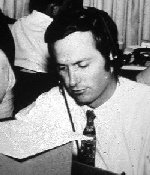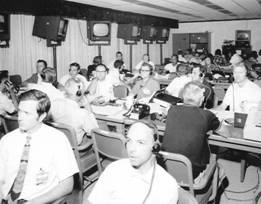On the night of April 13th, 1970, when the oxygen tank in Apollo 13’s Command and Service Module exploded, a 27-year-old engineer named Jerry Woodfill sat at his console in the Mission Evaluation Room at Johnson Space Center, monitoring the caution and warning system he helped create for the Apollo spacecraft.
“It was 9:08 pm, and I looked at the console because it flickered a few times and then I saw a master alarm come on,” Woodfill said, talking from his office at JSC where he has worked for almost 45 years. “Initially I thought something was wrong with the alarm system or the instrumentation, but then I heard Jack Swigert in my headset: “Houston, we’ve had a problem,” and then a few moments later, Jim Lovell said the same thing.”
And so began the most perilous but eventually triumphant situation ever encountered in human spaceflight.
2010 is the 40th anniversary of Apollo 13, and Universe Today had the chance to talk with Woodfill about his role in Apollo 13, a mission which many believe should have ended fatally for astronauts Jim Lovell, Fred Haise, and Jack Swigert. But it didn’t, and the mission has come to be called a “successful failure.”
What things were responsible for that success – the overcoming of odds – to rescue of the crew?
Since Woodfill was there in the thick of the action, he has some ideas on how to answer that question. But also, for the past 40 years he has studied the Apollo13 mission in intricate detail, examining all the various facets of the rescue by going through flight transcripts, debriefs, and other documents, plus he’s talked to many other people who worked during the mission. Fascinated by the turn of events and individuals involved who turned failure into success, Woodfill has come up with what he calls “13 Things That Saved Apollo 13.”
Over the next few weeks, we’ll share Woodfill’s insights and discuss each of those 13 turning points. What better way to celebrate the 40th anniversary of Apollo 13!
But for today, besides giving our readers a preview of what is to come the next 13 days, we’ll take this opportunity introduce you to Jerry Woodfill.

While attending Rice University on a basketball scholarship, Woodfill was inspired by President John F. Kennedy’s famous “We Choose to go to the Moon” speech delivered at Rice. Woodfill turned in his basketball shoes and focused on his studies of electrical engineering, hoping to become part of the space program.
He came on board at NASA just in time to work on helping to build the Apollo spacecraft.
“I spent years working with contractors, engineers, flight controllers and astronauts on the caution and warning system, or the alarm systems for both the lunar lander as well as the command ship,” Woodfill said.
He compared the alarm system to the lights that come on in an automobile when the battery is low or the generator isn’t working. “We had to come up with the best means of telling the astronauts they had a problem. We had to make sure the alarm system worked right. ”
Woodfill said that like most of the NASA team, he knew the workings of the command ship and lander more intimately than any of his college courses would have required, but that prepared him for any problems that might arise.

During the Apollo missions Woodfill worked in the Mission Evaluation Room, which is NOT the Mission Operations Control Room (MOCR) or “Mission Control” as it is known. MER was in a building adjacent to the Mission Control building. Woodfill has written a webpage detailing the difference between the MER and MOCR.
“We were an unsung group,” Woodfill said. “We were there for mission support. We weren’t flight controllers, but we were experts. For other missions that were routine we didn’t play that big of a role, but for the Apollo 13 mission, we did play a role.”
Woodfill tends to downplay both his role and the importance of the MER. “Comparing the 1970s era MER to the Mission Operations Control Room would be akin to comparing the Queen Mary to a weekend boater’s cabin cruiser,” he said. “Likewise, comparing my role in the rescue to Gene Kranz and Glen Lunney’s would be more incomparable.”
For a truly unbiased opinion, however, Chapter 11 of Jim Lovell’s book “Lost Moon” (renamed Apollo 13 after the movie of the same name came out in 1995) details how important the people in the Mission Evaluation Room were. Yes, the “MER-men” were important!
While many may say the way Apollo 13 turned out was luck or a fortuitous turn of events, Woodfill said he tends to lean towards providence.
Over the next 13 days, perhaps we’ll find out!
And if Woodfill’s name is familiar to Universe Today readers, you may recall how he found the “lost” lesson plans of the teacher in space, Christa McAuliffe, and brought them “back to life” so to speak, as they are now being used by many teachers and Challenger Learning Centers.
Listen to an interview of Jerry Woodfill that I did for the 365 Days of Astronomy podcast.
Additional Articles in the “13 Things That Saved Apollo 13” that have now been posted:
Part 1: Timing
Part 2: The Hatch That Wouldn’t Close
Part 3: Charlie Duke’s Measles
Part 4: Using the LM for Propulsion
Part 5: Unexplained Shutdown of the Saturn V Center Engine
Part 6: Navigating by Earth’s Terminator
Part 8: The Command Module Wasn’t Severed
Part 12: Lunar Orbit Rendezvous
Part 13: The Mission Operations Team
Also:
Your Questions about Apollo 13 Answered by Jerry Woodfill (Part 1)
More Reader Questions about Apollo 13 Answered by Jerry Woodfill (part 2)
Final Round of Apollo 13 Questions Answered by Jerry Woodfill (part 3)


Thank you for this Nancy. I look forward to the upcoming articles. This entire episode stands to illustrate the ingenuity and courage of the NASA engineers and scientists in the 1960s. I long for a return to this level of committment to space and science at NASA, the ESA, and other space agencies.
This should be a UT classic, thanks NA for a great primer.
My favorite was always the Duct Tape
Very nice approach to an Apollo 13 tribute.
Hope you’ll give due recognition to the Kansas Cosmosphere and Space Center in Hutchinson KN, which recovered the empty shell of the Apollo 13 Command Module from a dusty exhibition in Paris (yes, France) and painstakingly rebuilt it from some 85,000 parts scattered on NASA and vendors’ shelves.
“Houston we got a problem!”
Greatest misquote in recent years.
An excellent post, thank you Nancy!
Thoroughly looking forward to this – I’ll be glued. I think you could distill it all down though – what saved Apollo 13? The absolute brilliance of some of the finest minds the world has ever known who worked at (and for) NASA during those eventful days.
Let the articles that follow be a tribute to them!
Very interesting. Although I am more than a bit disappointed that he could do all this research, document all the incredible work that was done to save the astronauts and somehow come to the ridiculous conclusion that there was some sort of “providence” involved.
Why are people so motivated to try and credit some supernatural cause. Especially when it is impossible to point to any credible evidence. Just sad. But am still very interested in the actual facts he has to present.